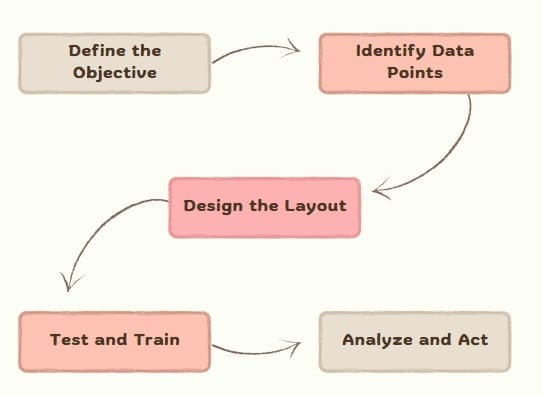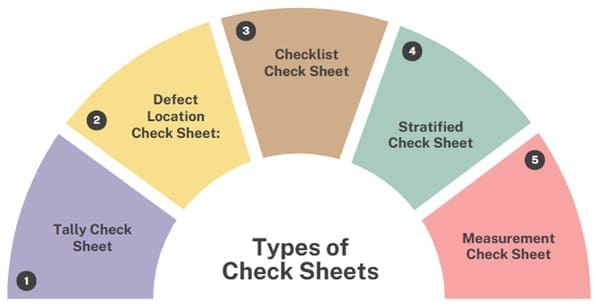The check sheet stands as a cornerstone tool for streamlining processes and ensuring excellence. Often referred to as a checksheet or check in sheet, this simple yet powerful tool captures data in real time, helping businesses identify patterns, reduce defects, and boost productivity.
Whether you’re a Six Sigma professional, a project manager, or a small business owner, mastering the check sheet can transform your approach to quality control.
Originally developed as part of the seven basic quality tools, check sheets have evolved into indispensable instruments across manufacturing, healthcare, service industries, and project management. Their effectiveness lies in their simplicity – anyone can use them without extensive training, yet they deliver profound insights into process behavior and quality issues.
Table of contents
What is a Check Sheet?
A check sheet is a structured, user-friendly form designed to collect and organize data systematically. Think of it as a tally sheet that records occurrences of specific events, defects, or observations in a clear, visual format. As one of the 7 basic tools of Total Quality Management (TQM), the check sheet simplifies data collection, making it accessible to teams across industries, from manufacturing to healthcare.
Its beauty lies in its versatility—whether you’re tracking errors in a factory or monitoring tasks in Google Sheets, a check sheet provides clarity and actionable insights.
By enabling teams to log data in real time, check sheets uncover trends, highlight problem areas, and pave the way for informed decision-making. Unlike complex software, a check sheet requires minimal training, making it a go-to QC tool for beginners and experts alike.
Origins of Check Sheets
The check sheet emerged as part of the 7 QC tools, pioneered by Dr. Kaoru Ishikawa in the 1960s. Ishikawa, a champion of quality improvement, believed that simple tools could solve up to 90% of quality issues. Inspired by Japan’s post-war industrial boom, he developed the seven tools of TQM, including the check sheet, to empower workers to tackle quality challenges systematically.
Today, check sheets are a staple in Six Sigma, Lean, and other quality analysis tools, proving their timeless value.
Public, Onsite, Virtual, and Online Six Sigma Certification Training!
- We are accredited by the IASSC.
- Live Public Training at 52 Sites.
- Live Virtual Training.
- Onsite Training (at your organization).
- Interactive Online (self-paced) training,
How to Create an Effective Check Sheet?

Crafting a check sheet is like designing a roadmap for quality. Here’s a step-by-step guide to ensure your check sheet delivers results:
Step 1: Define the Objective
Start by identifying the purpose of your check sheet. Are you tracking defects in a production line, monitoring customer complaints, or creating a Google Sheets check list for project tasks? A clear objective ensures your check sheet focuses on relevant data.
Step 2: Identify Data Points
Determine what data you need to collect. For example, in a check sheet quality control scenario, you might track defect types like scratches, misalignments, or missing parts. Be specific to avoid ambiguity.
Step 3: Design the Layout
Create a simple, organized layout with columns and rows. Include categories for data points, dates, times, or locations. For digital users, Google Sheets check templates offer customizable grids to streamline this process.
Step 4: Test and Train
Pilot your check sheet with a small team to ensure it’s user-friendly. Train staff to use it consistently, emphasizing the importance of accurate data entry.
Step 5: Analyze and Act
Once data is collected, analyze it to spot trends or recurring issues. Use insights to drive improvements, whether through process changes or further investigation with other 7 QC tools.
Also Read: Data Collection Sheet
Types of Check Sheets

Not all check sheets are created equal. Depending on your needs, you can choose from several types:
- Tally Check Sheet: Records frequency of occurrences, ideal for tracking defects or events. For example, a factory might tally machine breakdowns by type.
- Defect Location Check Sheet: Maps defects on a diagram, often used in manufacturing to pinpoint issues on a product.
- Checklist Check Sheet: A check list vs checklist debate often arises here, but both terms refer to a list of tasks or items to verify completion, like a Google Sheets check list for project milestones.
- Stratified Check Sheet: Groups data by categories (e.g., shifts, operators) to identify patterns.
- Measurement Check Sheet: Records quantitative data, such as temperature or dimensions, for precise analysis.
Each type serves a unique purpose, making check sheets adaptable to diverse scenarios.
Check Sheets in Six Sigma and Quality Control
In Six Sigma, the check sheet Six Sigma approach is integral to the DMAIC (Define, Measure, Analyze, Improve, Control) methodology. During the Measure phase, check sheets Six Sigma teams use to collect baseline data on process performance. For example, a Six Sigma check sheet might track defects in a call center’s response times, helping identify root causes in the Analyze phase.
Check sheets also complement other 7 tools of TQM, such as:
- Pareto Chart: Uses check sheet data to prioritize defects.
- Histogram: Visualizes frequency distributions from check sheet data.
- Cause-and-Effect Diagram: Pairs with check sheets to explore root causes.
By integrating with these quality problem solving tools, check sheets amplify their impact in quality control.
Also Read: Plan, Do, Check, Act (PDCA)
Check Sheets in the Digital Age
In today’s tech-driven world, Google Sheets has revolutionized how teams use check sheets. A Google Sheets check list offers real-time collaboration, cloud storage, and automation features like Google Sheet notifications. Here’s how to leverage Google Sheets for check sheets:
Creating a Google Sheets Check List
- Open Google Sheets and create a new spreadsheet.
- Design columns for data points (e.g., defect type, date, count).
- Use checkboxes for task-based check lists or dropdown menus for standardized inputs.
- Share the sheet with your team for collaborative data entry.
Setting Up Google Sheet Notifications
To stay updated, enable Google Sheet notifications:
- Go to Tools > Notification Rules in Google Sheets.
- Set alerts for changes (e.g., “Notify me when any changes are made”).
- Choose email or mobile notifications for real-time updates.
This digital approach enhances efficiency, especially for remote teams or large-scale projects.
Benefits of Using Check Sheets
Why choose check sheets over other quality analysis tools? Here are the key advantages:
- Simplicity: Easy to design and use, requiring minimal training.
- Real-Time Data: Captures issues as they occur, reducing recall errors.
- Versatility: Applicable across industries, from manufacturing to healthcare.
- Cost-Effective: Requires no expensive software or tools.
- Actionable Insights: Identifies patterns for targeted improvements.
For example, a check sheet example in a restaurant might track customer complaints about food quality, revealing a recurring issue with a specific dish that prompts recipe adjustments.
Challenges and Best Practices
While check sheets are powerful, they’re not foolproof. Common challenges include inconsistent data entry, vague categories, or lack of follow-up. To overcome these, follow these best practices:
- Standardize Categories: Ensure all users understand data points to avoid confusion.
- Train Teams: Provide clear instructions on how to use the check sheet.
- Review Regularly: Analyze data frequently to catch issues early.
- Combine with Other Tools: Pair check sheets with Pareto charts or control charts for deeper analysis.
Example
Imagine a car manufacturing plant using a check sheet quality control system to track defects during assembly. The check sheet includes categories like “paint scratches,” “misaligned parts,” and “electrical faults.” Workers mark occurrences during each shift, and after a week, the data reveals that 60% of defects are paint scratches. The team uses this insight to investigate painting processes, implement training, and reduce defects, boosting overall quality.
This check sheet example demonstrates how a simple tool can drive significant improvements when used effectively.
Check Sheet vs. Checklist
The check list vs checklist debate often causes confusion. A check sheet is a data collection tool focused on recording frequencies or occurrences, while a checklist is a list of tasks or items to verify completion. For instance, a Google Sheets check list might track project milestones, while a check sheet tallies defects. Both are valuable, but their purposes differ.
Check Sheets and the 7 QC Tools
As one of the 7 basic tools, the check sheet works in harmony with other quality problem solving tools:
- Flowchart: Maps processes to identify where to use check sheets.
- Pareto Chart: Prioritizes issues based on check sheet data.
- Histogram: Shows data distribution from check sheets.
- Cause-and-Effect Diagram: Explores causes of issues identified by check sheets.
- Control Chart: Monitors process stability using check sheet data.
- Scatter Diagram: Analyzes relationships between variables from check sheets.
- Check Sheet: Collects raw data for all other tools.
Together, these seven tools form a robust framework for quality improvement.
FAQs on Check Sheet
What is a check sheet in quality control?
A check sheet is a structured form used to collect and organize data in real time, often to track defects or events, aiding quality control efforts in Six Sigma or TQM.
How does a check sheet differ from a checklist?
A check sheet records frequencies or occurrences for analysis, while a checklist verifies task completion. For example, a Google Sheets check list tracks tasks, while a check sheet tallies defects.
How do I set up Google Sheet notifications for a check sheet?
In Google Sheets, go to Tools > Notification Rules, select “Notify me when changes are made,” and choose email or mobile alerts for real-time updates.
Which of the following is true regarding check sheets?
Check sheets are simple, versatile tools for collecting data in real time, used in Six Sigma and TQM to identify patterns and drive process improvements.
What are the 7 QC tools, and how does a check sheet fit in?
The 7 QC tools include check sheets, Pareto charts, histograms, cause-and-effect diagrams, control charts, scatter diagrams, and flowcharts. Check sheets collect data that supports other tools’ analyses.
Final Words
The check sheet is a deceptively simple yet transformative tool in the world of quality control. From its roots in the 7 QC tools to its modern applications in Six Sigma and Google Sheets, it empowers teams to collect, analyze, and act on data with precision. By identifying patterns, reducing defects, and fostering continuous improvement, check sheets are a must-have for any organization striving for excellence.



















